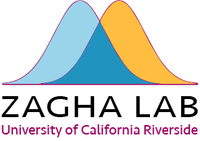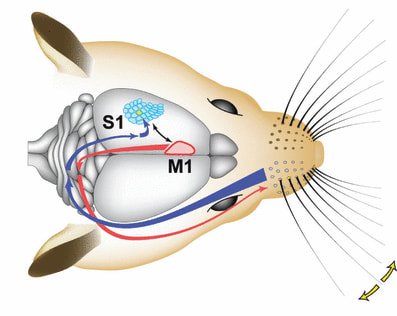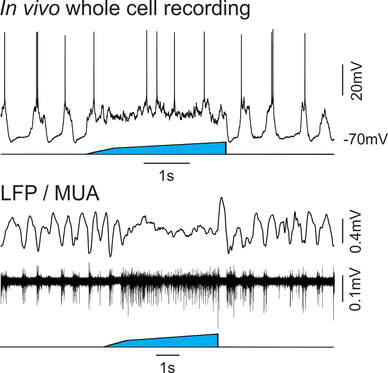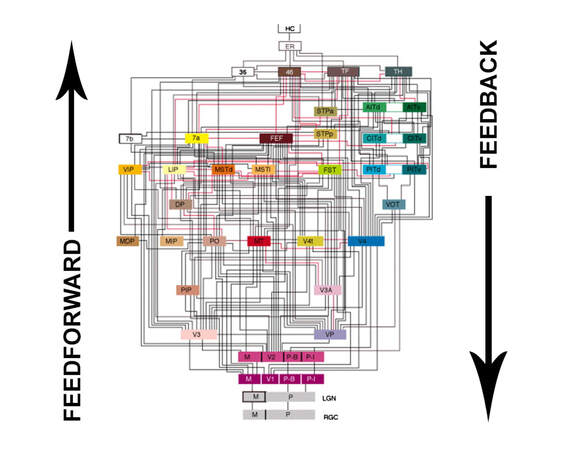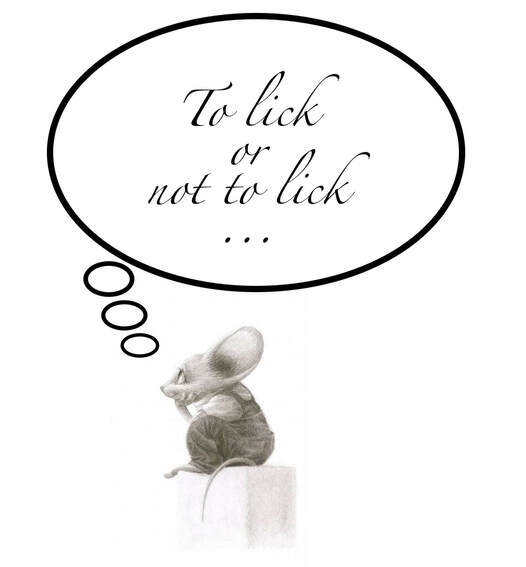Each morning we wake up to a world of possibilities. Despite being surrounded by the same external stimuli, we choose how to interact with those stimuli in order to accomplish our short- and long-term goals. My lab studies the roles of cortex in sensory and motor processing. Instead of framing this question as a fixed and unidirectional sensory-to-motor transformation, we try to understand how bidirectional cortical signaling enables flexible and goal-directed behaviors.
|
The anatomical organization of cortex appear to be an ideal substrate for bidirectional signaling. As described in the famous work of Felleman and Van Essen (1991), connections between cortical regions are most often bidirectional. Those connections from lower to higher order sensory regions (such as V1 to V2) are considered feedforward, and those from higher to lower order regions (such as V2 to V1) are considered feedback.
|
We study the mouse whisker system, enabling us to combine physiological, behavioral and genetic approaches in a mammalian model system. Sensory (lower order) and motor (higher order) regions of the mouse cortical whisker system are mono-synaptically connected, in both directions. We asked what effect stimulating motor cortex would have on the physiology of sensory cortex. We found that stimulating this cortical feedback pathway dramatically modulated spontaneous and sensory-evoked activity in sensory cortex (Zagha et al., 2013). Motor cortex stimulation changed the state of sensory cortex, shifting population dynamics from oscillatory and synchronized to rapid and asynchronous (a state also described as ‘activated’). Changes in cortical state strongly modulated sensory responses within sensory cortex, reducing variability and improving representation of the underlying stimulus. Thus, cortical feedback activation may be a tool that the brain uses to focus sensory encoding on stimuli that are particularly important for the task at hand.
Cortical activation has previously been studied as a property of long-range neuromodulators, such as acetylcholine. [Seminal work on the effects of acetylcholine on cortical state were conducted in the lab of John Ashe at UC Riverside, in the same department as our laboratory!] However, there are some notable differences between the effects of long-range neuromodulators and cortical feedback activation. First, motor cortex is capable of driving state changes in sensory cortex extremely rapidly, on the order of tens of milliseconds. Second, cortical feedback pathways have discrete targets, enabling spatial- and feature-specific activation patterns within cortex. For these reasons, we propose cortical feedback activation as a substrate for the cognitive processes of attention and expectation, which involve rapid and specific modulations of sensory-motor processing. Direct tests of these hypotheses are underway.
|
Our studies of cortical state also led us to question how ‘state’ is currently monitored. Is there more to cortical state than the rhythmicity of population cortical activity? We recently proposed cortical state as a high dimensional landscape of functional circuit properties, enabling the same anatomical circuit to perform diverse input-output operations (Zagha et al., 2016, Zagha 2020). In this framing, we consider that combinations of different neuromodulators (each with a different compliment of cellular targets) may be important for positioning circuits at different locations across the cortical state landscape. Our new framework additionally provides insights into how changes in cellular and synaptic properties alter input-output response properties.
|
An important feature of goal-directed behavior is NOT responding to each stimulus that comes our way. We implemented a selective sensory detection task in mice, in which mice must respond (lick) to target (whisker) stimuli and ignore distractor (auditory) stimuli. After two to three weeks of training mice become extremely well controlled in this task. Notably, responses to distractors were reduced significantly across training. Next, we found that suppressing activity in motor cortex abolished this learned behavior, increasing responses to distractors to rates commonly seen in untrained mice (Zagha et al., 2015). Thus, motor cortex plays an essential role in impulse control during this task. How do neurons in motor cortex carry out this function?
By recording neural activity during behavior, we observed different sensory- or motor-aligned spiking patterns. Computational modeling revealed how these spike patterns may reflect a decision-related circuit mediated by competing neural ensembles (Zagha et al., 2015). How do the different neurons in cortex organize to form this decision-related circuit? And which synaptic pathways are most important for controlling impulsive behavior? Stay tuned, as we continue to investigate these questions. |
